2nd Gen Cherry
RSP 11141
Grower: CO/GHA, LLC
General Information
- Sample Name
- VR Comparison
- Accession Date
- April 9, 2019
- Reported Plant Sex
- not reported
- Report Type
- StrainSEEK v2 3.2Mb
- DNA Extracted From
- Stem
The strain rarity visualization shows how distant the strain is from the other cultivars in the Kannapedia database. The y-axis represents genetic distance, getting farther as you go up. The width of the visualization at any position along the y-axis shows how many strains there are in the database at that genetic distance. So, a common strain will have a more bottom-heavy shape, while uncommon and rare cultivars will have a visualization that is generally shifted towards the top.
Chemical Information
Cannabinoid and terpenoid information provided by the grower.
Cannabinoids
No information provided.
Terpenoids
No information provided.
Genetic Information
- Plant Type
- Type III
File Downloads
The bell curve in the heterozygosity visualization shows the distribution of heterozygosity levels for cannabis cultivars in the Kannapedia database. The green line shows where this particular strain fits within the distribution. Heterozygosity is associated with heterosis (aka hybrid vigor) but also leads to the production of more variable offspring. When plants have two genetically different parents, heterozygosity levels will be higher than if it has been inbred or backcrossed repeatedly.
The ratio of reads mapped to Y-contigs to reads mapped to the whole Cannabis genome (Y-ratios) has been demonstrated to be strongly correlated with plant sex typing. This plot shows the distribution of Y-ratios for all samples in our database which were sequenced with the same method (panel or WGS) as this sample and where this sample falls in the distribution.
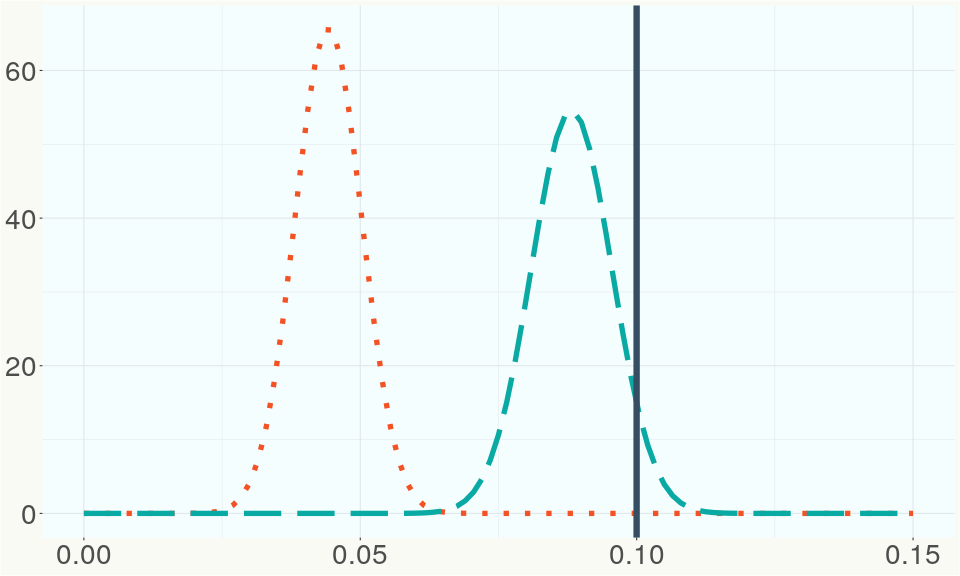
This chart represents the Illumina sequence coverage over the Bt/Bd allele. These are the three regions in the cannabis genome that impact THCA, CBDA, CBGA production. Coverage over the Active CBDAS gene is highly correlated with Type II and Type III plants as described by Etienne de Meijer. Coverage over the THCA gene is highly correlated with Type I and Type II plants but is anti-correlated with Type III plants. Type I plants require coverage over the inactive CBDA loci and no coverage over the Active CBDA gene. Lack of coverage over the Active CBDA and Active THCA allele are presumed to be Type IV plants (CBGA dominant). While deletions of entire THCAS and CBDAS genes are the most common Bt:Bd alleles observed, it is possible to have plants with these genes where functional expression of the enzyme is disrupted by deactivating point mutations (Kojoma et al. 2006).
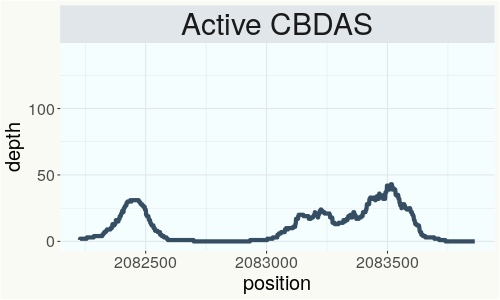
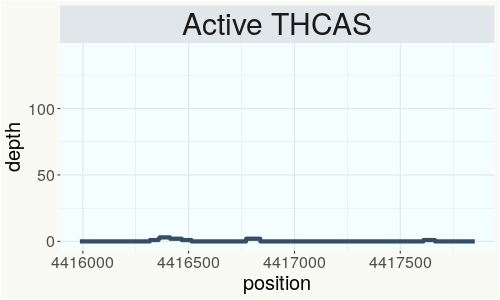
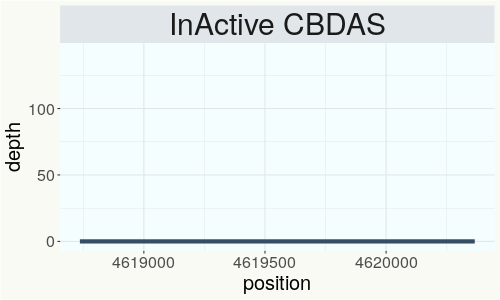
This chart represents the Illumina sequence coverage over the CBCA synthase gene.
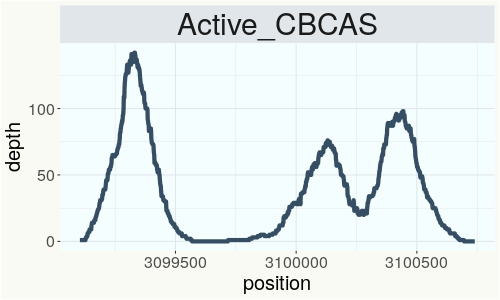
Variants (THCAS, CBDAS, and CBCAS)
Variants (Select Genes of Interest)
| PKSG-4a | c.493G>A | p.Gly165Ser | missense variant | moderate | contig700 | 1937904 | G/A |
|
| PKSG-2a | c.67T>A | p.Phe23Ile | missense variant | moderate | contig700 | 1945567 | A/T | |
| PKSG-2a | c.31A>T | p.Thr11Ser | missense variant | moderate | contig700 | 1945603 | T/A | |
| PKSG-2b | c.948T>G | p.Asp316Glu | missense variant | moderate | contig700 | 1950690 | A/C |
|
| PKSG-2b | c.945T>G | p.Ser315Arg | missense variant | moderate | contig700 | 1950693 | A/C |
|
| PKSG-2b | c.944G>A | p.Ser315Asn | missense variant | moderate | contig700 | 1950694 | C/T |
|
| PKSG-2b | c.934C>G | p.His312Asp | missense variant | moderate | contig700 | 1950704 | G/C |
|
| PKSG-2b | c.31A>T | p.Thr11Ser | missense variant | moderate | contig700 | 1951851 | T/A | |
| PKSG-4b | c.496A>G | p.Lys166Glu | missense variant | moderate | contig700 | 2721177 | T/C | |
| PKSG-4b | c.489delT | p.Phe163fs | frameshift variant | high | contig700 | 2721183 | CA/C | |
| PKSG-4b | c.485A>G | p.Lys162Arg | missense variant | moderate | contig700 | 2721188 | T/C | |
| PKSG-4b | c.431T>G | p.Val144Gly | missense variant | moderate | contig700 | 2721242 | A/C | |
| PKSG-4b | c.419A>G | p.Asp140Gly | missense variant | moderate | contig700 | 2721254 | T/C | |
| PKSG-4b |
c.352_355del |
p.Thr118fs | frameshift variant | high | contig700 | 2721317 | CCTGT/C |
|
| aPT1 | c.406A>G | p.Ile136Val | missense variant | moderate | contig121 | 2839605 | A/G | |
| aPT1 | c.629C>T | p.Thr210Ile | missense variant | moderate | contig121 | 2840237 | C/T | |
| HDS-2 |
c.82_93delGT |
p.Val28_Thr3 |
conservative inframe deletion | moderate | contig95 | 1989748 |
CGTAACCGGAAC |
|
| HDS-2 | c.127T>G | p.Ser43Ala | missense variant | moderate | contig95 | 1989794 | T/G |
|
Nearest genetic relatives (All Samples)
- 0.204 13 Cherries (RSP11442)
- 0.218 Durban Poison #1 (RSP11013)
- 0.218 Cherry Blossom (RSP11304)
- 0.218 Cherry Wine (RSP11145)
- 0.222 Cold Weather Stout (RSP11418)
- 0.234 Ringo s Gift -Katie s Cut- (RSP11624)
- 0.237 Cherry Blossom (RSP11332)
- 0.238 Cherry Blossom (RSP11321)
- 0.238 Cherry (RSP11143)
- 0.240 Otto (RSP11147)
- 0.245 Durban Poison #1 (RSP10996)
- 0.246 Electra (RSP11366)
- 0.246 UP Sunrise (RSP10989)
- 0.246 Joy (RSP11380)
- 0.248 Cold Weather Cherry (RSP11414)
- 0.248 FL30 7 11 2019 (RSP11361)
- 0.249 Sweet Grass (RSP11146)
- 0.251 Durban Poison (RSP11014)
- 0.252 Domnesia (RSP11184)
- 0.255 Blueberry Cheesecake (RSP10684)
Most genetically distant strains (All Samples)
- 0.441 Fatso (RSP11741)
- 0.439 Cherry Blossom (RSP11323)
- 0.436 RKM-2018-012 (RSP11103)
- 0.432 Chem 91 (RSP11185)
- 0.429 80E (RSP11212)
- 0.427 80E (RSP11213)
- 0.421 Black Triangle (RSP11638)
- 0.420 JL yellow (RSP11075)
- 0.420 RKM-2018-026 (RSP11118)
- 0.420 Abacus (RSP11266)
- 0.419 GMO (RSP12091)
- 0.419 Feral (RSP11205)
- 0.418 Red Eye OG (RSP11190)
- 0.418 Cherry Blossom (RSP11314)
- 0.416 Right Mark (RSP11628)
- 0.413 Dog Patch (RSP11725)
- 0.413 IUP2 (SRR14708257)
- 0.412 Santhica 27 (SRR14708211)
- 0.411 501st OG (RSP11241)
- 0.411 JL 3rd Gen Mother (RSP11214)
Nearest genetic relative in Phylos dataset
- Overlapping SNPs:
- 84
- Concordance:
- 58
Nearest genetic relative in Lynch dataset
- Overlapping SNPs:
- 6
- Concordance:
- 6
Blockchain Registration Information
- Transaction ID
-
64a8468126f514a3
341341f4ea8e9ff6 47cebeec0b1a3370 8c474473158bc767 - Stamping Certificate
- Download PDF (839.8 KB)
- SHASUM Hash
-
4188e69d1c8c3715601c50c73983d1d1 338608c4b2d4e3ca 7eb2fafb7807ad0d